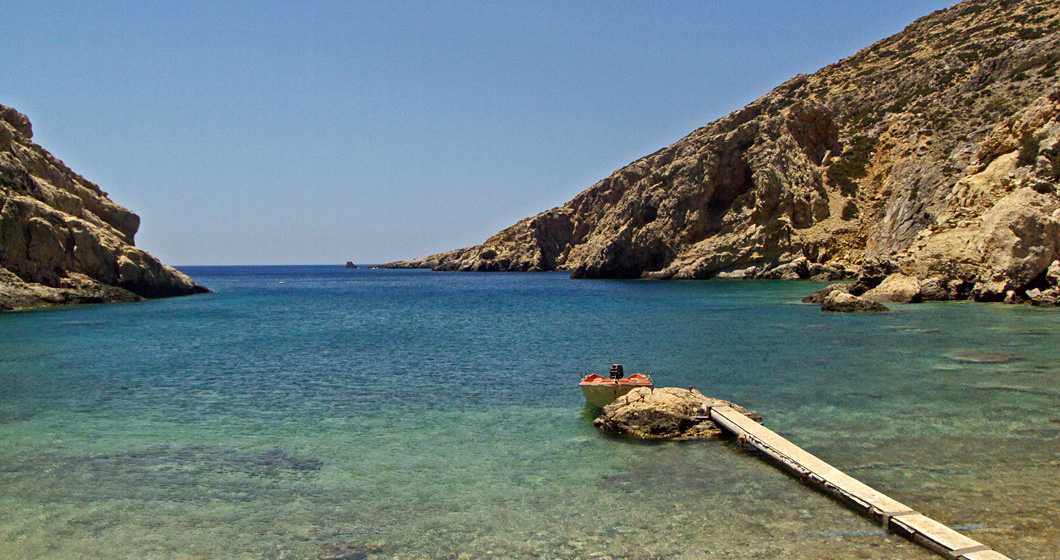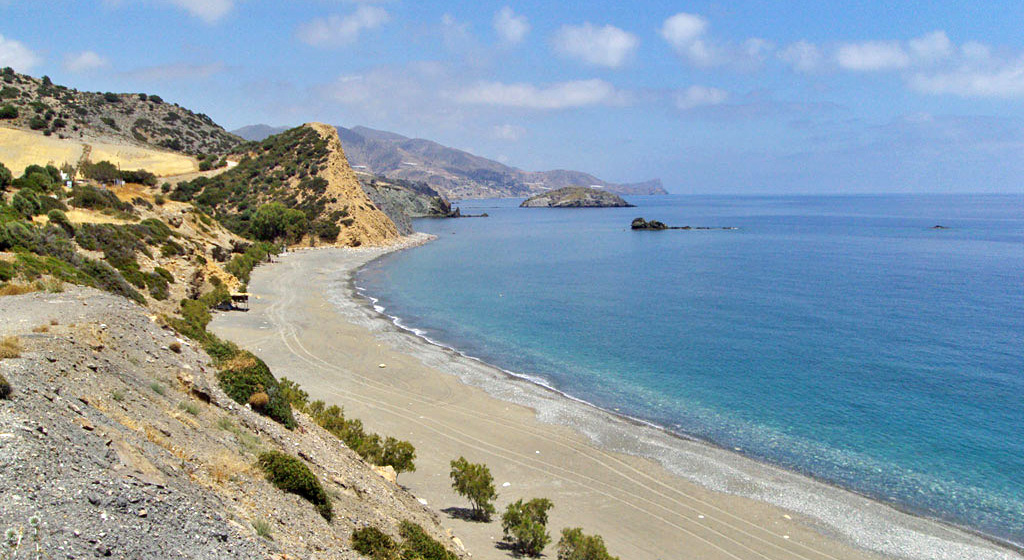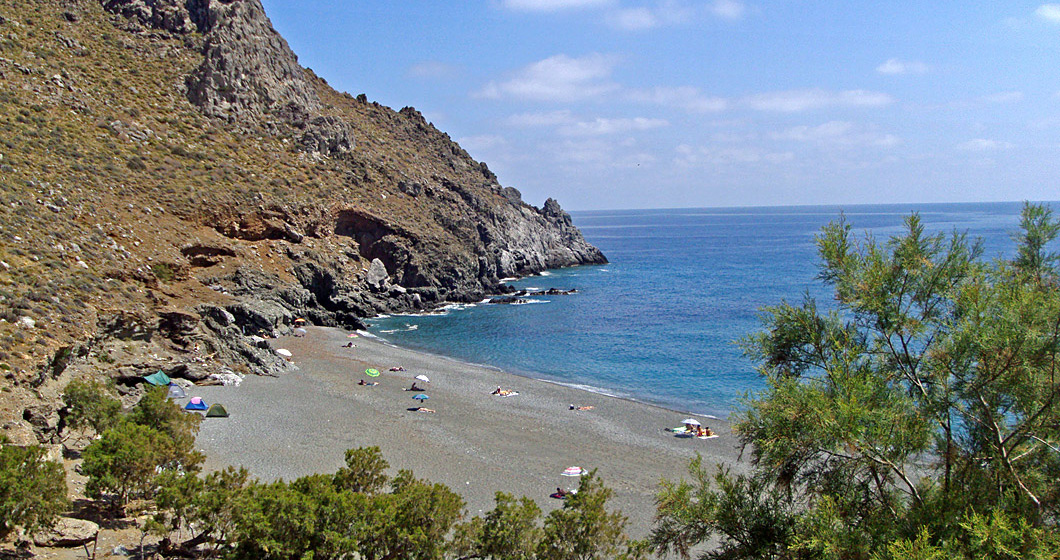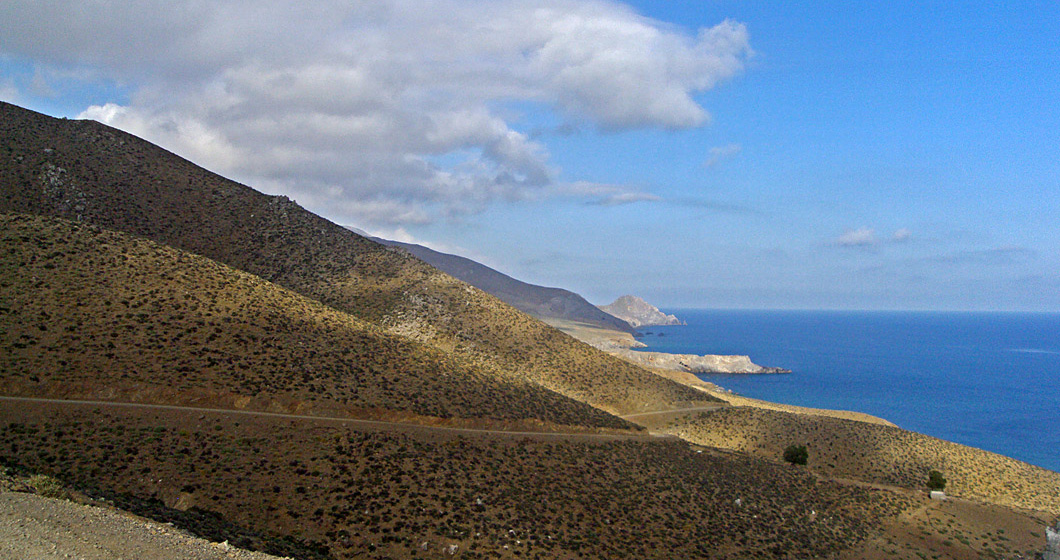This route connects the most important places of interest of the Asterousia area, such as archaeological sites, settlements, gorges and beaches. One can choose to follow whichever parts of the route that one finds most interesting. It should be noted, though, that the roads which climb up the slopes of the mountain range usually twist and turn, and in some cases they are not paved.
Vori - Phaestos - Hodegetria Monastery - Kali Limenes

All the rest of the mountain ranges of Crete are rugged and imposing, but the smallest among them, the low mountain range of the Asterousia, which covers all the southern part of the Heraklion Prefecture, is the barest and most mystifying of all.
Its southern slopes reach the charming Libyan Sea, creating small yet precipitous gorges which end up in beautiful secluded beaches.
We set off from the traditional settlement of Vori (1), where there is the most significant folklore museum. of Crete, that is, the Museum of Cretan Ethnology. There, one has the opportunity to learn about the mores and customs of traditional Cretan communities, the social organization in the island, and also about architecture, weaving and other folk elements of Crete.
We next make a stop at the famous Minoan Palace of Phaests where we can also enjoy a lovely view over the Messara plain. Phaestos, which is built on a low hill, is the second largest Minoan palace which has been unearthed. Nowadays, one can see the remains of both the old and the new palace.
The palace of Phaestos is famous for yet another reason: it is here that the Phaestos Disk, which is dated to the 17th century BC, was found. Its ancient use is one of the greatest mysteries of Antiquity. It can be seen in the Archaeological Museum of Heraklion.
Those who are interested in Archaeology perhaps would also like to visit several other important archaeological sites which are located nearby, such as Matala with the well-known caves, the Minoan villa at Agia Triada, the Minoan coastal town of Komos and the tholos tomb at Kamilari.
After Phaestós we pass through the traditional settlement of Ai Yannis, where we can visit the Byzantine church of Ai Yannis, and then continue to picturesque Siva village, which has a beautiful square and traditional tavernas.
We carry on in a southerly direction and after the village of Listaro we continue further southwards, until we arrive at the Hodegetria Monastery (2). A characteristic tower can be seen, which, according to tradition, was built by Nikephoros Phokas.
The monastery became famous thanks to Xopateras, a warrior monk, a hainis, who is still remembered today for his resistance activity against the Turks and for his tragic demise, which was linked to the history of the monastery.
We then continue southwards until we reach a junction where a dirt road can be seen on the right; this road leads to the entrance to the Agiofarango. We can park our car here and walk to this small yet fascinating gorge, which was named like this because it used to be one of the most important centres of ascetism in Crete (Agiofàrango = holy gorge).
After 25 minutes of walking we come to a chapel of Agios Antonios, which is built near the outlet of the gorge. A little further onwards we reach a beach, of unique beauty which is enclosed by imposing cliffs. Agiofarango is a place favourite with rock climbers; therefore, it is quite probable that you may spot climbers going up the steep vertical cliffs, during your walk down the gorge.

Equally beautiful is the nearby gorge of Martsalo. which is approximately 2 km long. After a short and fairly easy hike down the gorge, through a green landscape with age-old olive trees, carob trees and Phoenix theophrastii palms, we end up at the small, beautiful Martsalo beach.
In order to reach the entrance to the gorge, we follow the dirt road that begins opposite of the Hodegetria Monastery and ascends the hill south-west of the monastery.
We continue on the main road, traveling in a southerly direction as far as the long, calm beach of Kali Limenes (3), where the Apostle Paul sought temporary refuge during his voyage to Rome.
Kali Limenes is a protected beach, which remains calm even when strong winds rage in the surrounding area.
Kali Limenes -Tripiti

We continue on the dirt road eastwards, enjoying the view to the Libyan Sea, and trying to ignore the ugly greenhouses. This particular area is otherwise exceptionally beautiful. We carry on until we reach the small coastal settlement of Lentas (4) which is built on the site of the ancient town of Levin.
Levίn flourished in the Hellenistic and the Roman era as the port of Gortyna and a sacred town, since an Asklepieion (an ancient healing temple) was built here. Even today one can see the ruins of the temple of Asklepios dated to the 3rd century BC.
In the area of Lentas there are beautiful long beaches which attract campers and nudists, such as Diskos, Limanaki, Anatolikos Tsigounas and others.

We continue driving in an easterly direction as far as the little harbour of Loútra and from then onwards ascend northwards. At the first turn-off we take the eastern branch of the road until we arrive at Tripiti beach. The road climbs high on the mountain side, avoiding Cape Trafoulas.
Approximately halfway to Tripiti beach and as we descend on the eastern side of the cape, we reach a path which leads to the beach, via the small yet impressive Trafoulas gorge.
Tripiti beach is long and beautiful; however, it suffers from the makeshift camp site set up on the sand in the shade of the tamarisk trees. There are tavernas, for a meal or a coffee.
Tripiti - Kapetaniana (2 alternative routes) - Agii Deka

We leave the beach and enter the rocky gorge of Tripiti. We soon pass through the narrowest point of the gorge. The walls are only four metres apart, therefore it feels as if there is hardly any space for our car to pass through.
Having exited the gorge, we reach a road which meanders up the bare slopes of the Asterousia in an easterly direction.
It should be noted, though, that there is another road, a dirt road, which begins after the gorge of Tripiti and snakes up the slopes of the Asterousia in an easterly direction and ends at the village of Kapetaniana (5), which is suitable strictly for 4X4 off-road vehicles.
The best (and safest) way to reach Kapetanianà leads us again to the northern side of the Asterousia and to the village of Vagionia, where we turn right and drive southwards, so that we ascend again on the Asterousia massif, as far as Kapetaniana.
A large part of Kapetaniana has been restored and incorporated into a traditional hostel. The view to the Libyan Sea from this picturesque village, with the bleak and bare landscape and the steep slopes of the peak of Kofinas, is breathtaking. Kófinas is known for its rock climbing routes.
A Minoan peak sanctuary existed on Kofinas. The mountain retains its religious aura even today, since the festival of Timios Stavros (the True Cross) is celebrated here every year. In addition to that, an ancient custom of tree worship still survives.
Kapetaniana can be a base for exploring this part of the Asterousia.
In the areaone can visit the Koudouma Monastery which is located at the outlet of a small gorge and is surrounded by a beautiful pine forest. One can even stay overnight in one of the cells available to visitors.
One can also take the road which leads down to the coastal settlement of Ai Giannis, where the secluded beach of Eligia is located.
Alternatively, one can descend from Kapetaniana, reaching the villages Loukia and Vagionia and cross the plain of Messarà in a northerly direction as far as Agii Deka (6), where one can visit the antiquities of Gortyna.
The ancient town of Górtyna was the capital of Crete and of the Cyrenean peninsula during the Roman period, and for many centuries was the undisputed ruling town of the island. According to mythology, Zeus fled to Gortyna when, transformed into a bull, he abducted Europa.
Unfortunately, only a small part of the ancient town has been excavated. In the archaeological site which is open to visitors one can see the remains of the Byzantine church of Agios Titos (who was the first Bishop of Crete), the Roman Odeon, the Plane tree of Zeus and Europa as well as numerous Roman sculptures.





